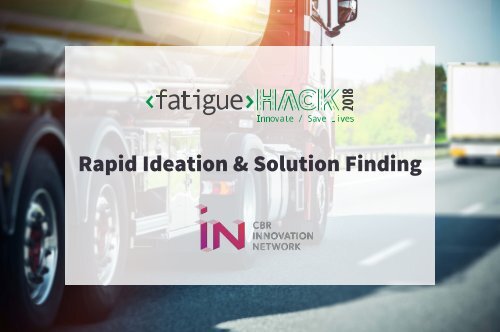ATA_Ideation_sm (1)
Create successful ePaper yourself
Turn your PDF publications into a flip-book with our unique Google optimized e-Paper software.
Rapid <strong>Ideation</strong> & Solution Finding
<strong>Ideation</strong> is not an event.<br />
<strong>Ideation</strong> is a process.<br />
PLAN<br />
INITIATE<br />
SYNTHESISE<br />
ASK<br />
THINK<br />
Rapid <strong>Ideation</strong> & Solution Finding
Plan.<br />
PLAN<br />
INITIATE<br />
SYNTHESISE<br />
ASK<br />
THINK<br />
Rapid <strong>Ideation</strong> & Solution Finding
It all begins with the user.<br />
Rapid <strong>Ideation</strong> & Solution Finding
Getting started.<br />
Identify a challenge:<br />
ex: You can’t eat ice-cream everywhere you want to.<br />
Don’t assume the answer in the question:<br />
ex: How might we create a dripless ice-cream cone?<br />
Be open for discovery, be specific enough for direction:<br />
ex: How might we redesign ice-cream to be more portable?<br />
Rapid <strong>Ideation</strong> & Solution Finding
Writing the challenge statement.<br />
Formulate “How might we…” questions.<br />
-framed with optimi<strong>sm</strong> and without judgement<br />
-is written in plain english<br />
-is not too broad or specific<br />
Rapid <strong>Ideation</strong> & Solution Finding
What is empathy?<br />
empathy<br />
/ˈɛmpəθi/<br />
noun<br />
the ability to understand and share the feelings of another.<br />
Design Thinking | Creating User-centric Products
Empathic Approach<br />
without judgment<br />
with a beginner’s eyes<br />
with curiosity<br />
optimistically<br />
respectfully<br />
Design Thinking | Creating User-centric Products
Why Empathic Design?<br />
The better we empathise with people, the<br />
easier we can create value for them - and<br />
success for organisations.<br />
Design Thinking | Creating User-centric Products
POV Components<br />
User:<br />
Teenager<br />
Need:<br />
To eat healthy food<br />
Insight:<br />
Certain nutrients are necessary for physical and<br />
cognitive health and development<br />
Design Thinking | Creating User-centric Products
POV Components<br />
User:<br />
Year 9 girl at a new school<br />
Need:<br />
To feel socially accepted while eating healthy food<br />
Insight:<br />
In her crew, a social risk is more dangerous than a<br />
health risk.<br />
Design Thinking | Creating User-centric Products
POV Components<br />
User:<br />
Year 9 girl at a new school<br />
Need:<br />
To feel socially accepted while eating healthy food<br />
Insight:<br />
In her crew, a social risk is more dangerous than a<br />
health risk.<br />
specific user<br />
deep need that’s<br />
hers not ours<br />
a surprising finding,<br />
rooted in empathy work<br />
Design Thinking | Creating User-centric Products
Frame your Problem Statement.<br />
As a<br />
customer/user<br />
I need a<br />
solution<br />
in order to<br />
solve a problem<br />
Design Thinking | Creating User-centric Products
Ask.<br />
PLAN<br />
INITIATE<br />
SYNTHESISE<br />
ASK<br />
THINK<br />
Rapid <strong>Ideation</strong> & Solution Finding
Introduce a strong innovation question to<br />
guide ideation.<br />
A good question will be simple, challenge the status quo,<br />
and be slightly counter-intuitive.<br />
Suggestive – “How might we…?”<br />
Devil’s Advocate – “What if money were no option?”<br />
Contrary – “What if it wasn’t open source?”<br />
Reversal – “What if the passengers served the air attendants?<br />
Time – “Imagine 20 years in the future/past…”<br />
Provocation – Photo/artifact/quote/statistic<br />
Rapid <strong>Ideation</strong> & Solution Finding
Initiate.<br />
PLAN<br />
INITIATE<br />
SYNTHESISE<br />
ASK<br />
THINK<br />
Rapid <strong>Ideation</strong> & Solution Finding
Start by reviewing ground rules for the<br />
brainstorm.<br />
In general, these are some good guidelines for an<br />
effective brainstorm:<br />
• Defer judgement<br />
• Encourage wild ideas<br />
• Build on the ideas of others<br />
• One conversation at a time<br />
• Be visual<br />
• Stay focused on the topic<br />
• Go for quantity<br />
• If you’re using post its, one per idea<br />
Rapid <strong>Ideation</strong> & Solution Finding
Think.<br />
PLAN<br />
INITIATE<br />
SYNTHESISE<br />
ASK<br />
THINK<br />
Rapid <strong>Ideation</strong> & Solution Finding
Part 1.<br />
Divergent thinking.<br />
This is the rapid creation of random, unorganized, wild, freeflowing,<br />
novel ideas in a short period of time. This method<br />
helps people to think outside the usual constraints. This type<br />
of thinking encourages people to get comfortable with ideas<br />
that may not be immediately valuable, but could provide the<br />
key ingredient for driving innovation.<br />
Rapid <strong>Ideation</strong> & Solution Finding
Part 2:<br />
Convergent thinking.<br />
This is a selective critique and combination of ideas in order to<br />
develop strong concepts.<br />
• intelligently refine ideas by strengthening them<br />
• combination forces new thinking and creativity around how<br />
new solutions can be made and differentiated<br />
• create clusters of complementary ideas and add more<br />
texture and detail by using affinity clustering<br />
Rapid <strong>Ideation</strong> & Solution Finding
Synthesise.<br />
PLAN<br />
INITIATE<br />
SYNTHESISE<br />
ASK<br />
THINK<br />
Rapid <strong>Ideation</strong> & Solution Finding
Bring it all together.<br />
Pick 3 of the strongest clusters and refine by imagining the<br />
scenario of usage and the social, emotional attributes your<br />
target user would experience or need to accomplish<br />
Draw a 3-6 storyboards for each solution and annotate with<br />
user detail<br />
MAKE IT BUILDABLE!<br />
Rapid <strong>Ideation</strong> & Solution Finding


